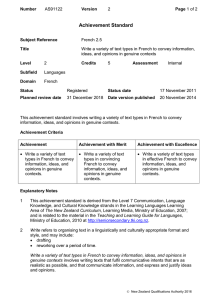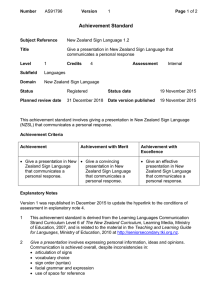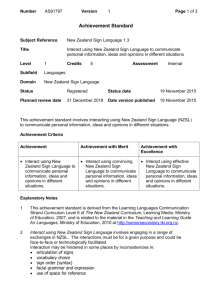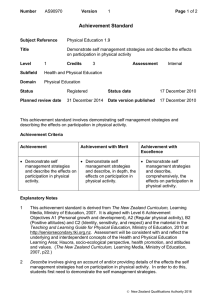Achievement Standard
advertisement
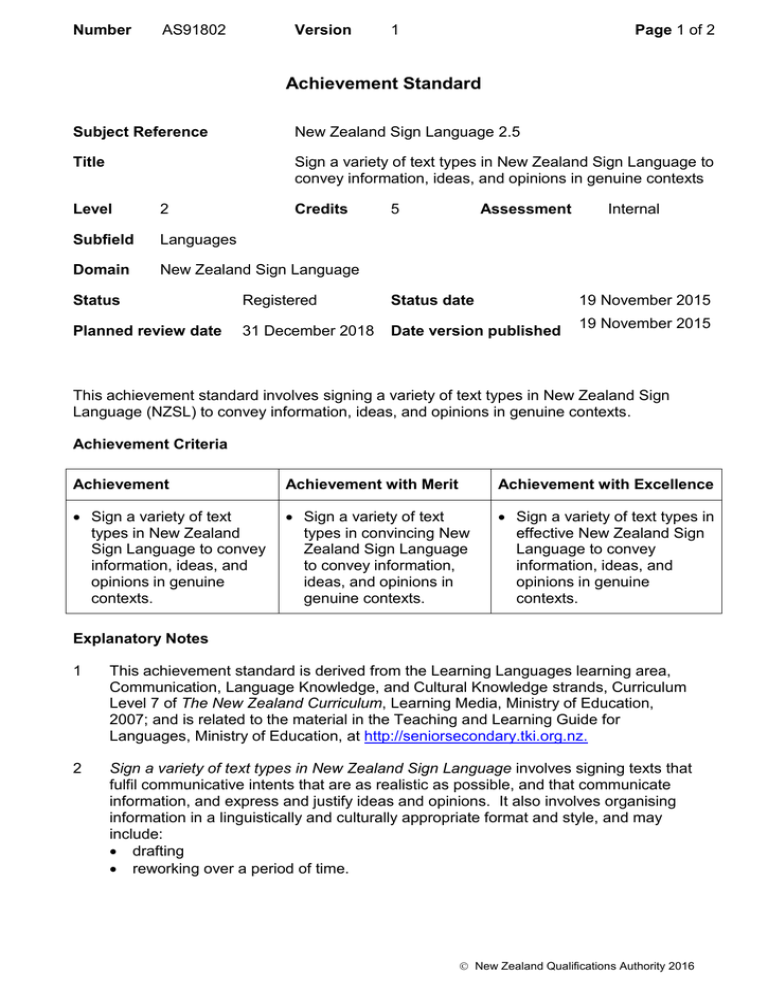
Number AS91802 Version 1 Page 1 of 2 Achievement Standard Subject Reference New Zealand Sign Language 2.5 Title Sign a variety of text types in New Zealand Sign Language to convey information, ideas, and opinions in genuine contexts Level 2 Credits Subfield Languages Domain New Zealand Sign Language 5 Assessment Internal Status Registered Status date 19 November 2015 Planned review date 31 December 2018 Date version published 19 November 2015 This achievement standard involves signing a variety of text types in New Zealand Sign Language (NZSL) to convey information, ideas, and opinions in genuine contexts. Achievement Criteria Achievement Achievement with Merit Achievement with Excellence Sign a variety of text types in New Zealand Sign Language to convey information, ideas, and opinions in genuine contexts. Sign a variety of text types in convincing New Zealand Sign Language to convey information, ideas, and opinions in genuine contexts. Sign a variety of text types in effective New Zealand Sign Language to convey information, ideas, and opinions in genuine contexts. Explanatory Notes 1 This achievement standard is derived from the Learning Languages learning area, Communication, Language Knowledge, and Cultural Knowledge strands, Curriculum Level 7 of The New Zealand Curriculum, Learning Media, Ministry of Education, 2007; and is related to the material in the Teaching and Learning Guide for Languages, Ministry of Education, at http://seniorsecondary.tki.org.nz. 2 Sign a variety of text types in New Zealand Sign Language involves signing texts that fulfil communicative intents that are as realistic as possible, and that communicate information, and express and justify ideas and opinions. It also involves organising information in a linguistically and culturally appropriate format and style, and may include: drafting reworking over a period of time. New Zealand Qualifications Authority 2016 Number AS91802 Version 1 Page 2 of 2 Communication is achieved overall, despite inconsistencies, such as: articulation of signs vocabulary choice sign order (syntax) facial grammar and expression use of space for reference fluency and pace of delivery. Sign a variety of text types in convincing New Zealand Sign Language involves developing and connecting information, ideas, and opinions in NZSL that is generally credible. A range of language and language features are selected and used that are fit for purpose and audience. Communication is not significantly hindered by inconsistencies. Sign a variety of text types in effective New Zealand Sign Language involves developing and integrating information, ideas, and opinions in NZSL that is controlled. A range of language and language features that are fit for purpose and audience are capably selected and successfully used. Communication is not hindered by inconsistencies. 3 Genuine contexts refers to real-life rather than contrived or artificial situations. Where situations involve simulation, the simulation should be as realistic as possible: i.e. plausible, rather than contrived. 4 Variety refers to a range of different texts created for different audiences and purposes. 5 The quality of the texts, considered as a whole, is more important than the length. 6 A range of commonly used real-life resources may be used to support drafting and reworking. 7 Conditions of Assessment related to this achievement standard can be found at www.tki.org.nz/e/community/ncea/conditions-assessment.php. Quality Assurance 1 Providers and Industry Training Organisations must have been granted consent to assess by NZQA before they can register credits from assessment against achievement standards. 2 Organisations with consent to assess and Industry Training Organisations assessing against achievement standards must engage with the moderation system that applies to those achievement standards. Consent and Moderation Requirements (CMR) reference 0233 New Zealand Qualifications Authority 2016


